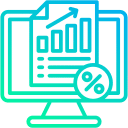1. It makes it easier to do Skill gap analysis
Skill gap analysis opens ways to identify the gap between employee skills and the skills an organization needs to fulfill its goals, coupled with peer input. A strategic upskilling plan is more than just about advancing talent development. Employees can also identify limiting beliefs, behaviors, and gaps impeding their job performance. They can reveal these pain points through periodic knowledge checks and self-evaluations to get back on track.
Certification paths focusing on communication or interpersonal skills, for example, could be part of your upskilling strategy. If employees want to pursue leadership positions and continually improve their skills, they can put their active listening and empathy to the test.
2. Gap analysis opens up personalized learning paths
Digital transformation enables training through paths as per personal skill gaps that are best for the employee and the organization. Learning personalization is now a reality thanks to modern talent development technology like LXP, which made it possible to deliver individualized and complex learning experiences at scale.
But this is no longer the case. It is counterproductive to a growing and diverse workplace to approach workplace development with a mentality that says “one size fits all.” Instead, employees need to be evaluated and acknowledged for their specific skills, technological fluency, and learning approach.
3. It becomes easier to track individual learning progress
Using an upskilling platform for tracking learning through analytics and reports helps monitor learner progress toward achieving the desired goals. An effective upskilling and reskilling platform will provide valuable statistics to track your learners’ activity and progress. Monitoring overall scores, success rates, and even time spent on online learning will provide additional insight into how well your training is received.
Quizzes and pop quizzes are a great way to see how well your employees are absorbing information. If you think your learners need a refresher course based on a skill gap analysis, don’t be afraid to reassign training and implement a digital transformation
4. Have the right talent in the right place
One main benefit of upskilling is that it makes it possible to ensure the employee has the required skill set to perform his job to the best. Employees have the opportunity to improve their skillset and reimagine their future career paths through the process of upskilling. It demonstrates that you care about their personal growth and development when launching an upskilling and reskilling employees program.
The company will reap direct benefits from this as you cultivate a team of highly qualified professionals and reduce the costs associated with training new hires. Establishing an employee’s sense of value within the company, which fosters loyalty and, ultimately, increases employee retention.
5. Saves your company’s time and money
Upskilling helps L&D managers & HR to customize the space with self-features for company specific learning needs saving time and money. More than 60% of the time is spent on course creation, with only 5% spent on strategy and storyboarding. This impacts the rollout timeline and budget and the effectiveness of the eLearning courses.
Upskilling your workforce enables you to spend more time on your strategy and creating a storyboard than anything else to improve the effectiveness of your courses. You won’t have to spend as much time updating and personalizing with the right tools and libraries. There isn’t much to learn about course authoring when using automated eLearning tools. The learning manager or instructional designer can act as the course developer, saving time, money, and resources.








